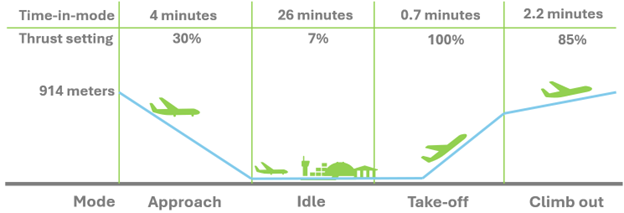LAQ Technology Standards
ICAO Technology Standards on LAQ are reflected in Annex 16, Volume II – Engine Emissions. They address liquid fuel venting, non-volatile Particulate Matter (nvPM) impacts from mass and particles number perspectives, and the main gaseous exhaust emissions from jet engines, namely: hydrocarbons (HC), oxides of nitrogen (NOx), carbon monoxide (CO).
The engine certification process is based on the Landing and Take-off (LTO) cycle. This LTO cycle representing pollutant emissions in the vicinity of airports consists of four operating modes, which involve a thrust setting and a time-in mode shown in Figure 1.

Figure 1 - Illustration of ICAO emissions certification procedure representing the LTO cycle
The engine certification process is performed on a test bed. For each thrust setting and corresponding fuel flow, the pollutant emissions are measured in accordance with the relevant SARPs. The submission of this data to the certificating authority is mandated as part of the engine emissions certification. This certification data is collected and stored in the publicly available ICAO emissions databank.
The approval of non-volatile Particulate Matter (nvPM) mass and number Standards is a ground breaking achievement. The development of this new standard marks the completion of the final component of aircraft environmental certification, closing the full circle on noise, local air quality and CO2 Standards for subsonic aeroplanes.
This new Standard was adopted by the ICAO Council in March 2020. The new Standard is applicable from 1 January 2023 onwards to new type and in-production engines with rated thrust greater than 26.7kN. The limit lines for nvPM mass and number provide some alleviation for engines with rated thrusts below 150kN. The new nvPM mass and number limit lines are presented on Figure 2.
 |  |
Figure 2. The CAEP/11 LTO nvPM mass (left) and number (right) regulatory limits for in-production and new type engines of rated thrust greater than 26.7 kN.
ICAO has also developed practical guidance for certificating authorities on the implementation of the technical procedures of Annex 16, which are contained in the Environmental Technical Manual on the use of Procedures in Emissions Certification of Engines (Doc 9501, Volume II).
For the new triennium (2025-2028), ICAO CAEP will keep its high pace on addressing LAQ issues and progressing the related work items. Specifically, CAEP will develop new NOx LTO stringency options based on the existing NOx metrics and building upon already reached progress on this topic.